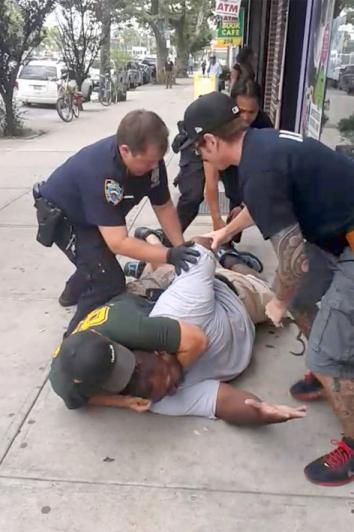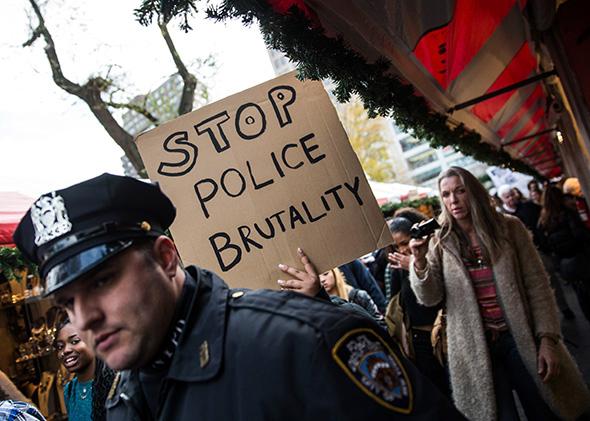Eric Garner never had a chance.
Or, to be more accurate, the cops never gave him one. Rather than talk to Garner, whom they approached on a Staten Island corner, police used force. Officer Daniel Pantaleo used a chokehold to bring him to the ground, and officers joined the struggle in an attempt to subdue Garner, whose only “crime” was asking police to leave him alone. He went into cardiac arrest, and died.
That sudden escalation in the use of force isn’t unusual. In April, Dontre Hamilton was killed—shot 14 times—after an altercation with Officer Christopher Manney, who confronted him in a Milwaukee park after complaints that Hamilton was sleeping on the ground. An attempted pat-down led to a scuffle, in which Manney says Hamilton took his baton and started hitting him. Soon after, Manney shot and killed the mentally ill man. (It’s worth noting that, in his memo detailing the event, Manney described Hamilton as “muscular” and “impossible to control if you were one-man.” According to the autopsy report, Hamilton was 5-foot-7 and an overweight 169 pounds.)
In August, just days before Officer Darren Wilson shot Michael Brown in Ferguson, Missouri, 22-year-old John Crawford was killed by police in an Ohio Walmart. Crawford—who was holding an air gun while talking to his family on the phone—didn’t have a chance, either. In less than a minute, police rounded a corner, shouted a command, and shot him, hitting Crawford and sending him to the emergency room, where he died of his wounds.
Later that same month, in St. Louis, Kajieme Powell was shot by police while allegedly wielding a butter knife outside a convenience store. By all accounts, including a video, he wasn’t an actual threat. Despite this, police entered close—erasing any space between them and Powell—and drew their guns, firing several shots and killing the 25-year-old, who also suffered from mental illness.
A few weeks later, in South Carolina, Levar Jones was shot and wounded by state trooper Sean Groubert at a gas station near Columbia. According to the dash-camera video, Groubert asked Jones to show his ID. When Jones tried to comply—he was standing outside his car, reaching for his wallet—Groubert drew his weapon, yelled for Jones to “Get out of the car,” and opened fire. He shot several times at Jones, striking him in the hip and prompting a bewildered response. “What did I do, sir?” he asked. “Why did you shoot me?”
Most recently, Cleveland police killed 12-year-old Tamir Rice after receiving a call that a “juvenile” was in a public area with a gun that was “probably” fake. In the video released by authorities, Rice is holding an air gun and standing in an empty park. A police car rolls into view—stopping just a few feet from Rice—and an officer jumps out, shooting. Seconds later, Rice is on the ground, dying.
The common thread in all of these isn’t police violence as much as it’s the sudden use of force. The victims never have a chance to react. Instead, police enter, weapons drawn, ready to kill. And when they do kill, they almost never face criminal charges. On Wednesday a grand jury declined to indict Officer Pantaleo with any charges in the death of Garner, despite video of his escalation, his use of an illegal chokehold, and his history of racial bias. Likewise, grand juries declined to press charges against the officers who killed Crawford, and the St. Louis police department is dragging its feet in the investigation of the officers who killed Powell. Prosecutors have yet to make a decision in the case of Officer Manney, and while the Rice shooting is still under investigation, the odds are that those officers will escape charges as well, despite the fact that the officer who used his weapon—Timothy Loehmann—had been described as “unfit for duty.” It’s only in South Carolina that the officer is facing trial for his actions.
In our current conversations on police violence, many observers have focused on the moral value of the victims—do “black lives matter”? This makes sense. Because black Americans bear the brunt of police violence, they are also the ones most burdened by a legal system that refuses to hold officers accountable. What’s more, as Adam Serwer notes for BuzzFeed, this is compounded by potent and prevalent stereotypes about black Americans and crime. “Police are people, after all, subject to the same flaws and vices as the rest of us. America’s police departments tend to be whiter than the general population, and nearly half of whites believe ‘many’ or ‘almost all’ black men are violent,” writes Serwer.

Photo by New York Daily News/Contributor via Getty Images
But while we should ask the legal system if “black lives matter,” we should also ask police departments to explain themselves and their training. Take away the implicit racial bias, the unfair treatment, and pervasive overpolicing, and you’re still left with a world where police are empowered by law to use force and are ready to use it without serious provocation. And worse, this is bolstered by a police culture that expects absolute obedience from ordinary citizens, regardless of the circumstances or situation. “[H]ere is the bottom line,” wrote veteran officer Sunil Dutta in an August op-ed for the Washington Post, “if you don’t want to get shot, tased, pepper-sprayed, struck with a baton, or thrown to the ground, just do what I tell you.” If any reaction—even the nervousness and fear that come with a police stop—is legitimate grounds for violence, then violence is practically guaranteed. And given the heavy policing in black and Latino communities, this means minorities are at the greatest risk for victimization.
To that point, Attorney General Eric Holder announced on Thursday that the Civil Rights Division of the Justice Department had found a “pattern or practice” of brutality and incompetence in the Cleveland police department. According to the report, officers were careless with weapons—“placing themselves, subjects, and bystanders at unwarranted risk of serious injury or death”—and aggressive with the public. In one case, notes the Huffington Post, “a 300-pound officer punched a 13-year-old boy who was handcuffed inside a police car and kicking the door. The officer, whom the report describes as 8 inches taller than the boy, punched him ‘three to four times’ until he was ‘stunned/dazed’ and had a bloody nose.”
Changing the culture of policing to de-emphasize violence and leave room for ordinary human behavior won’t be easy, but it’s possible. And it doesn’t have to lead to more crime. In Philadelphia this year, police have shot and killed just three people, compared with 12 by this point in 2013 and 16 by this point in 2012. What changed? The culture, and specifically, the department’s approach to the use of force. After a local news story found a spike in officer-involved shootings despite a drop in crime, the police commissioner invited federal officials to examine the department’s practices as part of a “collaborative review.”
The full report isn’t public, but the recommendations included new directives involving the use of force—in which officers state that they “hold the highest regard for the sanctity of human life” and the “application of deadly force is a measure to be employed only in the most extreme circumstances”—and intensive training designed to de-escalate confrontations before they turn deadly. “As the new policies have been phased in,” notes Philly.com, “the total number of shootings to date—fatal and nonfatal—has plummeted from 48 in 2012 to 35 in 2013 and to 18 so far this year, according to the department.”
If police departments are as committed to protecting communities as they claim, then they should welcome these steps. Bad cops—violent cops—hurt the profession as a whole. They create mistrust, and it make it hard for good officers to do their jobs. And on the other end, a legal system that won’t prosecute bad officers or hold them accountable for errors—or even record and document police shootings—is one that generates anger and hostility.
After the grand jury announced its decision in the case of Officer Pantaleo, New York Gov. Andrew Cuomo asked residents to “respect the legal process and rule of law.” But respect goes both ways, and a system that tolerates and supports bad police is one that breeds contempt from the people it’s supposed to protect. We see it in the mass protests sparked by the Garner case, as people show their anger and disdain for law enforcement. For police, this is dangerous. At best, it leaves you with communities where residents refuse to cooperate with police, where they would rather tolerate crime than work with an institution that hates them and treats them as subhuman. At worst, it explodes into fire, as people reach their limits and rebel against the all-but-official decree that their lives don’t matter.
